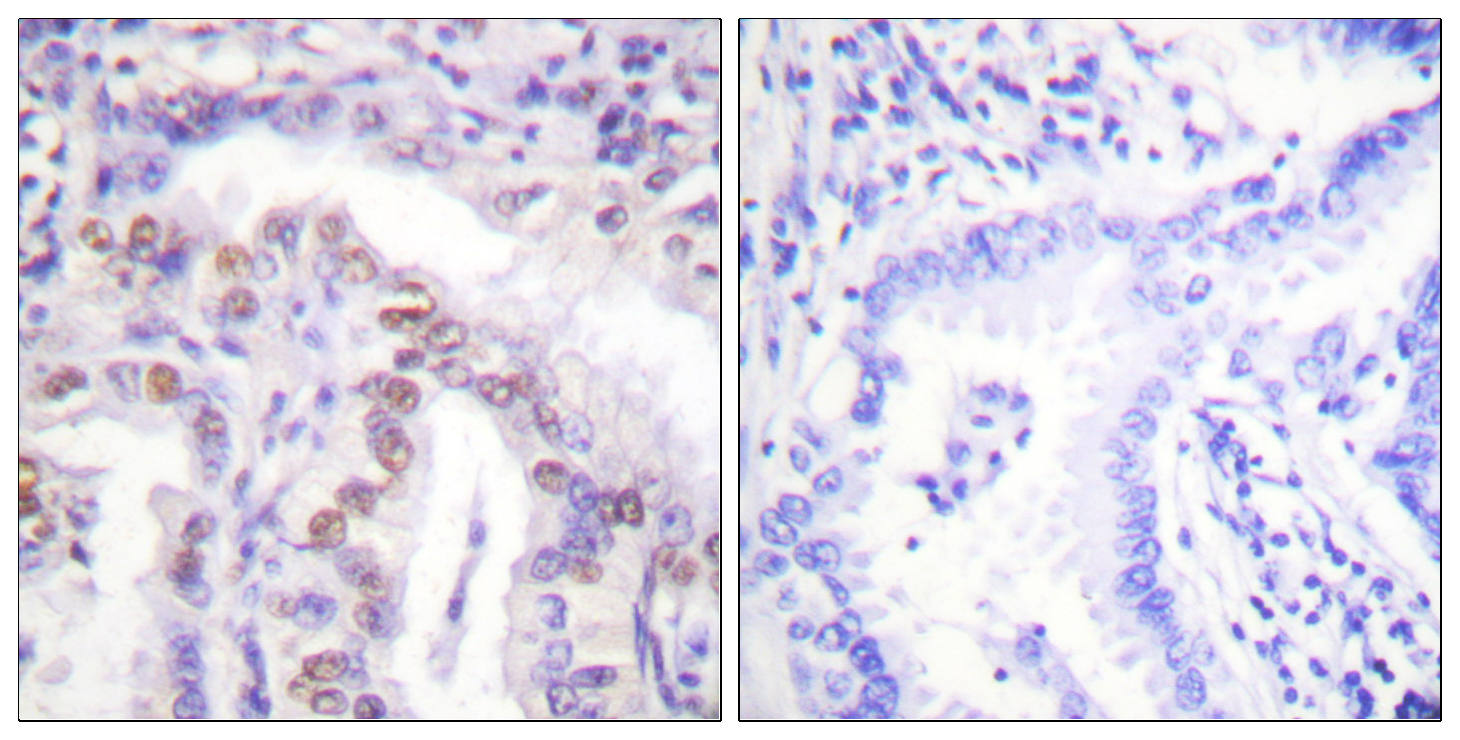SENP6 Polyclonal Antibody
- Catalog No.:YT4240
- Applications:IHC;IF;ELISA
- Reactivity:Human;Mouse
- Target:
- SENP6
- Gene Name:
- SENP6
- Protein Name:
- Sentrin-specific protease 6
- Human Gene Id:
- 26054
- Human Swiss Prot No:
- Q9GZR1
- Mouse Swiss Prot No:
- Q6P7W0
- Immunogen:
- The antiserum was produced against synthesized peptide derived from human SENP6. AA range:1042-1091
- Specificity:
- SENP6 Polyclonal Antibody detects endogenous levels of SENP6 protein.
- Formulation:
- Liquid in PBS containing 50% glycerol, 0.5% BSA and 0.02% sodium azide.
- Source:
- Polyclonal, Rabbit,IgG
- Dilution:
- IHC 1:100 - 1:300. ELISA: 1:10000.. IF 1:50-200
- Purification:
- The antibody was affinity-purified from rabbit antiserum by affinity-chromatography using epitope-specific immunogen.
- Concentration:
- 1 mg/ml
- Storage Stability:
- -15°C to -25°C/1 year(Do not lower than -25°C)
- Other Name:
- SENP6;KIAA0797;SSP1;SUSP1;FKSG6;Sentrin-specific protease 6;SUMO-1-specific protease 1;Sentrin/SUMO-specific protease SENP6
- Molecular Weight(Da):
- 126kD
- Background:
- Ubiquitin-like molecules (UBLs), such as SUMO1 (UBL1; MIM 601912), are structurally related to ubiquitin (MIM 191339) and can be ligated to target proteins in a similar manner as ubiquitin. However, covalent attachment of UBLs does not result in degradation of the modified proteins. SUMO1 modification is implicated in the targeting of RANGAP1 (MIM 602362) to the nuclear pore complex, as well as in stabilization of I-kappa-B-alpha (NFKBIA; MIM 164008) from degradation by the 26S proteasome. Like ubiquitin, UBLs are synthesized as precursor proteins, with 1 or more amino acids following the C-terminal glycine-glycine residues of the mature UBL protein. Thus, the tail sequences of the UBL precursors need to be removed by UBL-specific proteases, such as SENP6, prior to their conjugation to target proteins (Kim et al., 2000 [PubMed 10799485]). SENPs also display isopeptidase activity for
- Function:
- function:Protease that deconjugates SUMO1, SUMO2 and SUMO3 from targeted proteins. Does not seem to be involved in the processing of full-length SUMO proteins to their mature forms. Deconjugates SUMO1 from RXRA, leading to transcriptional activation. May act preferentially on substrates containing 3 or more SUMO2 or SUMO3 moieties.,similarity:Belongs to the peptidase C48 family.,subunit:Interacts with RXRA.,tissue specificity:Highly expressed in reproductive organs, such as testis, ovary and prostate.,
- Subcellular Location:
- Nucleus .
- Expression:
- Highly expressed in reproductive organs, such as testis, ovary and prostate.
- June 19-2018
- WESTERN IMMUNOBLOTTING PROTOCOL
- June 19-2018
- IMMUNOHISTOCHEMISTRY-PARAFFIN PROTOCOL
- June 19-2018
- IMMUNOFLUORESCENCE PROTOCOL
- September 08-2020
- FLOW-CYTOMEYRT-PROTOCOL
- May 20-2022
- Cell-Based ELISA│解您多样本WB检测之困扰
- July 13-2018
- CELL-BASED-ELISA-PROTOCOL-FOR-ACETYL-PROTEIN
- July 13-2018
- CELL-BASED-ELISA-PROTOCOL-FOR-PHOSPHO-PROTEIN
- July 13-2018
- Antibody-FAQs
- Products Images

- Immunohistochemistry analysis of paraffin-embedded human lung carcinoma, using SENP6 Antibody. The picture on the right is blocked with the synthesized peptide.



